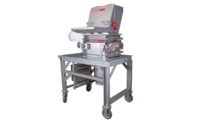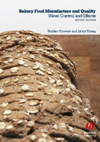Company: Syntegon
Website: www.syntegon.com
Packaging Snapshot: Syntegon is launching the Distribution Continuous Slide (DCS), a new highly flexible discharge station for round cookies, crackers, and biscuits. The modular discharge system consists of one or more stations arranged one behind the other. These are equipped with belt slides for particularly gentle handling, minimizing mechanical stress and thus reducing product breakage and loss. Providing optimum pack style flexibility, the Syntegon DCS distributes cookies onto belt legs for packing them flat or on-edge into pile, slug or tray packs. Furthermore, the system's guard-free design provides operators with unrestricted process visibility, safe accessibility and easy cleaning.
Cookies, biscuits, and crackers are taken from the cooling conveyor and are continuously distributed to the leg belts. They are neither pushed nor dropped but slide over the belts and are thereby protected from any mechanical stress. This reduces product loss significantly and leads to efficiency gains, especially when handling particularly sensitive products.
The higher the speed of the belt slide, the more cookies are transferred to downstream leg belts by the DCS. On the individual legs, a further belt slide, arranges the straight product stream into an S-shape. This arrangement ensures the cookies’ and crackers’ are evenly distributed across the entire width of the belt, preventing them from wedging or overlapping. A homogeneous product stream is created, ensuring a constant feed to the packaging machine.
Thanks to its gentle handling, the Syntegon DCS works particularly efficiently and ensures high output and product quality. The system is equipped to handle even briefly fluctuating production volumes intelligently, triggered for example by the failure of a packaging leg.
“Individual discharge stations can run at full speed to avoid production loss,” explains Daniel Bossel, global product manager at Syntegon. “If the product build up on a leg belt becomes too long, the DCS automatically discharges fewer products onto that leg. At the same time, it distributes the surplus to the next stations, automatically increasing their discharge capacity. All legs can continue to operate constantly—until the product storage is empty. In this way, the DCS enables maximum storage times with minimum storage lengths—a significant efficiency advantage.”
The design of the Syntegon DCS also provides high format flexibility: no format parts are installed in the discharge station. For a format change, it is sufficient to modify the belt speeds via the HMI module and save them as a new format. With flat feeders, chicane conveyors arrange the products into columns and feed them to the packaging machine in a constant product stream. With on-edge handling, products are gently transported by vibration to the packaging leg in ZF vibratory channels. The DCS discharge station requires shorter vibratory channel lengths than conventional solutions to achieve the same storage times—another important layout and cost advantage. In addition, manufacturers can add further DCS stations to the discharge system on a modular basis. In this manner, larger production volumes can be handled if the oven capacity is expanded at a later date.
Not only the flexibility of the machine, but also its optimized design confirm the efficiency of the construction. Thanks to the conveyors used within the DCS, additional safety guarding is no longer necessary. Since cleaning requires only a few manual steps, downtimes are reduced. Operators can easily view each process step and reach all machine sections for maintenance purposes.
“Due to the price-sensitive market environment, food manufacturers need to focus on solutions that deliver maximum efficiency gains. Therefore, the Syntegon DCS is designed with a low total cost of ownership in mind,” says Bossel. “Our goal was to develop an innovative and product-friendly system which equips food companies for the challenges of the future. Already we have customers confirm that we have managed to do just that with the DCS discharge station—and a patent for the technology is also pending.”








